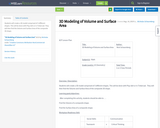
Students will create a 3D model comprised of 3 different shapes. This will be done with Play-doh or in Tinkercad. They will then find the Volume and Surface Area of the composite 3D shape.

Students will create a 3D model comprised of 3 different shapes. This will be done with Play-doh or in Tinkercad. They will then find the Volume and Surface Area of the composite 3D shape.
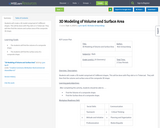
Students will create a 3D model comprised of 3 different shapes. This will be done with Play-doh or in Tinkercad. They will then find the volume and surface area of the composite 3D shape.
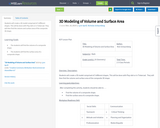
Students will create a 3D model comprised of 3 different shapes. This will be done with Play-doh or in Tinkercad. They will then find the volume and surface area of the composite 3D shape.
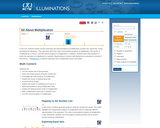
This unit consists of four lessons in which students explore several meanings and representations of multiplication, including number lines, sets, arrays, and balance beams. They also learn about the commutative property of multiplication, the results of multiplying by 1 and by 0, and the inverse property of multiplication. Students write story problems and create pictographs. The unit includes activity sheets, assessment ideas, links to related applets, reflective questions for students and teachers, extensions and a bibliography of children's literature with a multiplication focus.
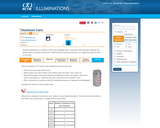
In this data analysis activity students investigate data in connection with recyclable materials and develop plans to help the environment. Students collect data about aluminum can usage and graph that data in a line plot. The lesson includes student worksheet and extension suggestions.

In this lesson plan students conduct a survey of ten students, collect data in a tally chart, and then display and analyze the results in a bar graph. In the analysis students must compare numbers, add, and subtract using the data in the bar graph to generate questions as well as answer them. The lesson plan includes a graph template, a link to an interactive graphing tool, extension questions, and a fact family sheet to show the related facts from their graph analysis.
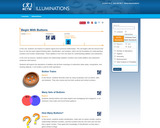
In this 8-lesson unit students use buttons to explore logical and numerical relationships that form the conceptual basis for understanding addition and subtraction operations. Topics include counting, ordinal numbers (and relative position), classification (attributes), relationships between numbers, addition of sets, commutativity of addition, sums to 10, fact families (including subtraction), three models of subtraction ("take away", comparative, missing addend), and bar graphs. Includes student activity sheets and a link to an online graphing applet.

The three teachers of the third and fourth grade team joined forces to create these standards-aligned resources. We discussed a middle-school curriculum unit, Birds & Flight, that one of us had written about fifteen years ago regarding using math to study and understand birds in different ways. As a team, we translated some of those concepts into middle-elementary activities.We discussed that the lessons could be taught in any order, but recommend using the Actual Size lesson as a fun capstone project.
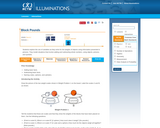
In this Illuminations lesson plan students explore the use of variables as they solve for the weights of objects using information presented in pictures. Learners model situations that involve adding and subtracting whole numbers, using objects, pictures, and symbols. A student activity sheet is available and downloadable (pdf).
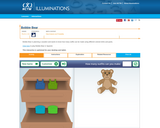
This interactive applet introduces students to the topic of combinations, a basic concept in probability. Users create combinations of shirts and pants to determine the total number of possible outfits. They may simply explore by placing the clothes on Bobbie, or make a guess and then test it. The number of shirt and pants choices is customizable. An optional voice provides prompts and feedback.

This Java applet activity allows students to explore the various situations described in "The Chairs Around the Table" lesson (cataloged separately). The user can select Exploration mode, in which the number of chairs needed for a particular arrangement of tables is displayed; or Guess, in which the user is able to construct an arrangement and then predict the number of chairs. There are two types of tables to choose from and two different table arrangements. Instructions and exploration question are provide.
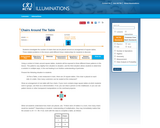
In this lesson from Illuminations, students explore and discover linear relationships. Linear patterns are identified, extended and described verbally, numerically and algebraically through three investigations. Using manipulatives and the linked applet, "Chairs", learners determine the number of chairs needed when the number of tables is known, and vice versa. Instructional plan, questions for the students, assessment options, extensions and teacher reflections are provided.
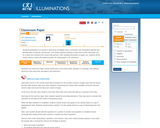
In this data collection and analysis activity students investigate data in connection with recyclable materials and develop plans to help the environment. This activity requires students to keep track of their own paper use for a week, graph the data with a line graph and then interpret their results with a partner. The lesson includes student worksheets and extension suggestions.

This lesson develops number skills, understanding of coin values, and the concept of equivalence. Students use coin blocks, concrete representations of the value of coins (pennies, nickels, dimes, and quarters), to compose and decompose values up to a dollar. The resource includes a 3-minute video for teachers on how to build the coin blocks prior to the lesson. An interactive game, Coin Box, provides additional practice for students and is cataloged separately.

This 2-lesson unit focuses on combinations, a subject related to probability. Students develop strategies for discovering all the possible combinations in two given situations. They learn to collect and organize data and then use the results to generalize methods for determining possible combinations. They discuss how the number of possible outcomes is affected by decisions about the order of choices, or whether choices may be repeated. The unit includes student activity sheets, questions and extensions for students, and a link to an interactive applet.
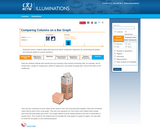
In this lesson plan students learn to create bar graphs using unifix cubes, translate this representation to graph paper, and then compare the data that has been collected and displayed. Students are encouraged to make up their own questions about the data (favorite juice) and to practice with multiple sets of data. Sample questions for students and extension ideas are included. The lesson contains links to a PDF of graph paper and the Bar Grapher tool which is cataloged separately in this database.
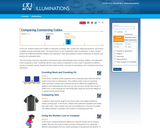
In this 6-lesson unit, students explore 5 models of subtraction (counting, sets, number line, balanced equations, and inverse of addition) using connecting cubes. The lesson activities focus on the comparative mode of subtraction as children investigate the relationship between addition and subtraction, write story problems in which comparison is required, and practice the subtraction facts. The lessons include printable student activity sheets, a bibliography of children's counting books, questions for student discussion and teacher reflection, assessment options, extensions, and links to online applets (cataloged separately).
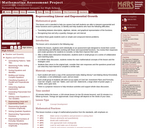
This lesson unit is intended to help teachers assess how well students are able to interpret exponential and linear functions and in particular to identify and help students who have the following difficulties: translating between descriptive, algebraic and tabular data, and graphical representation of the functions; recognizing how, and why, a quantity changes per unit intervale; and to achieve these goals students work on simple and compound interest problems.

This unit contains two lessons which help students develop number sense through activities involving collection, representation, and analysis of data. Students also practice reading and writing large numbers and develop estimation skills. In Lesson 1, Every Breath You Take, students estimate the number of breaths taken during a specified time, experiment, and display real-life data. In Lesson 2, Making Your First Millions, students develop the concept of a million by working with smaller numerical units, such as blocks of 10 or 100, and then expanding the idea by multiplication or repeated addition. They analyze situations and identify patterns that will enable them to develop the concept of large numbers. Each lesson includes student activity sheets, an instructional plan, and extensions.
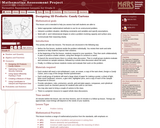
This lesson unit is intended to help teachers assess how well students are able to: Select appropriate mathematical methods to use for an unstructured problem; interpret a problem situation, identifying constraints and variables, and specify assumptions; work with 2- and 3-dimensional shapes to solve a problem involving capacity and surface area; and communicate their reasoning clearly.